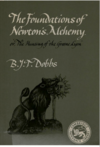Difference between revisions of "Affinity of reaction"
| Line 5: | Line 5: | ||
}} | }} | ||
Communicated by [[Gnaiger E]] (2018-12-27) | Communicated by [[Gnaiger E]] (2018-12-27) | ||
[[File:Dobbs 1975 Cambridge Univ Press.png|right|100px|link=Dobbs 1975 Cambridge Univ Press]] | |||
== Attraction and repulsion == | == Attraction and repulsion == | ||
::::* Isaak Newton: ''And as in Algebra, where affirmative Quantities vanish and cease, there negative ones begin; so in Mechanicks, where Attraction ceases, there a repulsive Virtue ought to succeed.'' [3] | ::::* Isaak Newton: ''And as in Algebra, where affirmative Quantities vanish and cease, there negative ones begin; so in Mechanicks, where Attraction ceases, there a repulsive Virtue ought to succeed.'' [3] | ||
Revision as of 08:11, 28 December 2018
Description
According to the IUPAC definition, the affinity of reaction, A [J/mol], equals the negative molar Gibbs energy of reaction [1], which is the negative Gibbs force of reaction [2]. The concept of affinity and hence chemical force is deeply rooted in the notion of attraction (and repulsion) of alchemy, and is seen as a key inspiration for Newton in his development of the concept of the gravitational force [3-5]. This marks a transition of the meaning of affinity from the descriptive 'adjacent' (proximity) to the causative attractive (force) [6]. Correspondingly, Lavoisier (1790) equates affinity and force [7]: “... the degree of force or affinity with which the acid adheres to the base” [6]. By discussing the influence of electricity and gravity on chemical affinity, Liebig (1844) considers affinity as a force [8]. This leads to Guldberg and Waage's mass action ratio ('Studies concerning affinity', 1864; see [7]) and chemical thermodynamics of irreversible processes [9], where flux-force relations are center stage [10]. The historical understanding of affinity is summarized in the conclusion, that today affinity should be considered as an isomorphic motive force, and be generalized as such without confusing changes of signs (attraction = negative repulsion) and variety of symbols.
Abbreviation: A
Reference: Cohen 2008 IUPAC Green Book
Communicated by Gnaiger E (2018-12-27)
Attraction and repulsion
- Isaak Newton: And as in Algebra, where affirmative Quantities vanish and cease, there negative ones begin; so in Mechanicks, where Attraction ceases, there a repulsive Virtue ought to succeed. [3]
References
- Cohen ER, Cvitas T, Frey JG, Holmström B, Kuchitsu K, Marquardt R, Mills I, Pavese F, Quack M, Stohner J, Strauss HL, Takami M, Thor HL (2008) Quantities, Units and Symbols in Physical Chemistry. IUPAC Green Book 3rd Edition, 2nd Printing, IUPAC & RSC Publishing, Cambridge. - »Bioblast link«
- Gnaiger E (1993) Nonequilibrium thermodynamics of energy transformations. Pure Appl Chem 65:1983-2002. - »Bioblast link«
- Dobbs BJT (1975) The foundations of Newton's alchemy or "The hunting of the Greene Lyon". Reissued as a paperback 1983. Cambridge Univ Press Cambridge:300 pp. - »Bioblast link«
- White M (1997) Isaak Newton. The last sorcerer. Fourth Estate, London 402 pp. - »Bioblast link«
- Schettino V (2017) Isaac Newton and alchemy. Substantia 1:69-76. - »Bioblast link«
- Raffa RB, Tallarida RJ (2010) ‘Affinity’: historical development in chemistry and pharmacology. Bull Hist Chem 35:7-16. - »Bioblast link«
- Lavoisier AL (1790) Elements of chemistry (translation by Kerr R, Dover Publications, New York, 1965:1–511.
- Liebig J (1844) Influence of heat, light, electricity, and gravity on chemical affinity. Lancet 8:209-11. - »Bioblast link«
- De Donder T, Van Rysselberghe P (1936) Thermodynamic theory of affinity: a book of principles. Oxford, England: Oxford University Press:144 pp.
- Prigogine I (1967) Introduction to thermodynamics of irreversible processes. Interscience New York, 3rd ed:147 pp. - »Bioblast link«
Template:Keywords Membrane potential
MitoPedia concepts:
Ergodynamics

